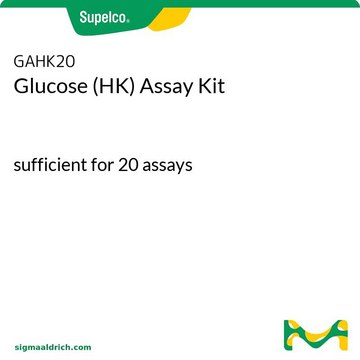MAK083
Glucose Uptake Colorimetric Assay Kit
sufficient for 100 colorimetric tests
Iniciar sesiónpara Ver la Fijación de precios por contrato y de la organización
About This Item
Código UNSPSC:
12161503
NACRES:
NA.84
Productos recomendados
uso
sufficient for 100 colorimetric tests
método de detección
colorimetric
enfermedades relevantes
endocrinological disorders, diabetes; cancer
temp. de almacenamiento
−20°C
Descripción general
Glucose is the primary source of energy for most cells. Glucose uptake into cells is highly regulated and the first rate limiting step in glucose metabolism. Glucose uptake is facilitated by the GLUT family of transporter proteins, whose expression and activity are regulated by multiple mechanisms. Glucose uptake is upregulated in many cancer cells, which exhibit high rates of aerobic glycolysis. Cells exhibiting insulin resistance show diminished glucose uptake in response to insulin stimulation.
The use of the recycling amplification reaction in the colorimetric assay results in the limit of detection being 10-fold lower (20-100 pmole) compared to the fluorescence assay (200-1,000 pmole, MAK084).
The use of the recycling amplification reaction in the colorimetric assay results in the limit of detection being 10-fold lower (20-100 pmole) compared to the fluorescence assay (200-1,000 pmole, MAK084).
Aplicación
Glucose uptake colorimetric assay kit has been used to measure glucose uptake by a variety of cells.
Idoneidad
Suitable for detecting glucose uptake in adherent or suspension cells cultured in a 96-well microtiter plate.
Principio
The Glucose Uptake Colorimetric Assay kit provides a simple and direct procedure for measuring glucose uptake in a variety of cells. Glucose uptake is measured using the glucose analog, 2-deoxyglucose (2-DG), which is taken up by cells and phosphorylated by hexokinase to 2-DG6P. 2-DG6P cannot be further metabolized and accumulates in cells, directly proportional to the glucose uptake by cells. In this assay, 2-DG uptake is determined by a coupled enzymatic assay in which the 2-DG6P is oxidized, resulting in the generation of NADPH, which is then determined by a recycling amplification reaction in which the NADPH is utilized by glutathione reductase in a coupled enzymatic reaction that produces glutathione. Glutathione reacts with DTNB to product TNB, which is detected at 412 nm.
Producto relacionado
Referencia del producto
Descripción
Precios
sustituido por
Referencia del producto
Descripción
Precios
Certificados de análisis (COA)
Busque Certificados de análisis (COA) introduciendo el número de lote del producto. Los números de lote se encuentran en la etiqueta del producto después de las palabras «Lot» o «Batch»
¿Ya tiene este producto?
Encuentre la documentación para los productos que ha comprado recientemente en la Biblioteca de documentos.
Heng-Jing Hu et al.
Frontiers in pharmacology, 12, 690371-690371 (2021-12-25)
Atrial fibrosis is the basis for the occurrence and development of atrial fibrillation (AF) and is closely related to the Warburg effect, endoplasmic reticulum stress (ERS) and mitochondrion dysfunctions-induced cardiomyocyte apoptosis. Hydrogen sulfide (H2S) is a gaseous signalling molecule with
Yu-Yong Wang et al.
Disease markers, 2022, 9516774-9516774 (2022-05-17)
Prostate cancer (PCa) is one of the most common malignancies in men with high death rate worldwide. Paclitaxel (Taxol) is a widely used anticancer agent. Despite recent improvements in clinical application and research, development of drug resistance limits the efficacy
PLIN2 inhibits insulin-induced glucose uptake in myoblasts through the activation of the NLRP3 inflammasome.
Cho K A and Peter B K
International Journal of Molecular Medicine, 36(3), 839-844 (2015)
Méndez-Martínez Marisol et al.
Scientific reports, 9(1), 13372-13372 (2019-09-19)
Obesity is caused by lipid accumulation in adipose tissues inducing adipocyte dysfunction, characterized by insulin resistance, increased lipolysis, oxidative stress, and inflammation, leading to increased levels of adipokines. Herein the capacity of the subfractions (SFs) SF1, SF2, and SF3 from
MicroRNA-138 suppresses proliferation, invasion and glycolysis in malignant melanoma cells by targeting HIF-1α.
Chen Y, et al.
Experimental and Therapeutic Medicine, 11(6), 2513-2518 (2016)
Nuestro equipo de científicos tiene experiencia en todas las áreas de investigación: Ciencias de la vida, Ciencia de los materiales, Síntesis química, Cromatografía, Analítica y muchas otras.
Póngase en contacto con el Servicio técnico

![2-Deoxy-2-[(7-nitro-2,1,3-benzoxadiazol-4-yl)amino]-D-glucose ≥97% (HPLC)](/deepweb/assets/sigmaaldrich/product/structures/104/527/40bd5a41-ebc4-484e-a10e-891fecfaea79/640/40bd5a41-ebc4-484e-a10e-891fecfaea79.png)



